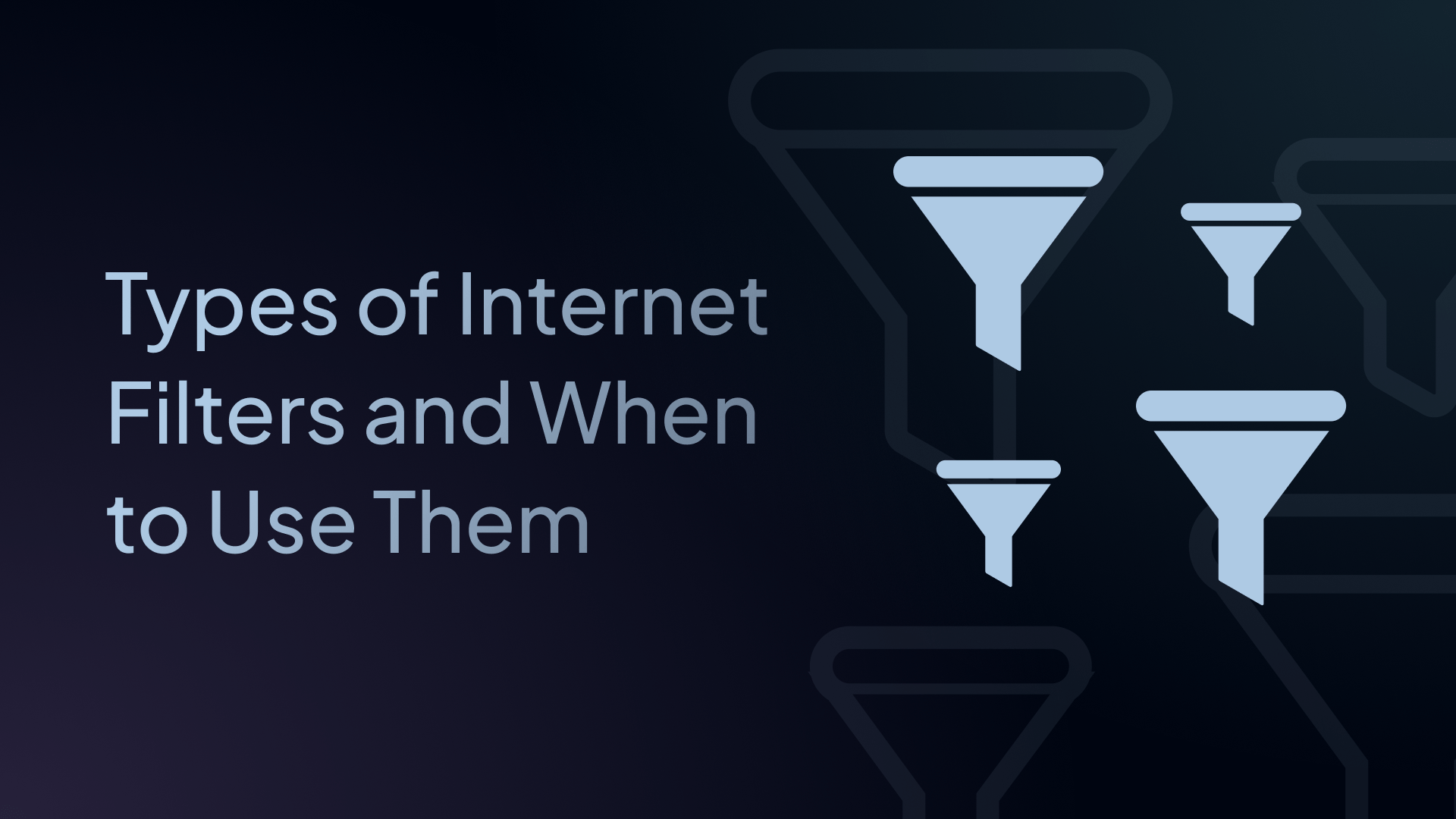5 Types of Internet Filters and When to Use Them
Learn the types of internet filters – DNS, content, URL, proxy, browser – and when to use each for safer, faster browsing at work, school, or home.

Not all internet filters are created equal, and choosing the wrong one can leave dangerous gaps in your protection or frustrate users with overblocking.
Whether you're managing a school network, securing company devices, or setting up parental controls at home, understanding how each type of internet filter works is key to getting the balance right between safety and accessibility.
In this guide, we’ll break down the main types of internet filters, looking at how they work, where they shine, and when each one actually makes sense.
Once you’re ready to choose a tool, head over to our expert roundup of the best internet filtering software solutions in 2025 to find the best fit for your needs.
5 Types of Internet Filters and When to Use Them
1. DNS-Based Filters: The Gatekeeper
DNS filtering works at the Domain Name System (DNS) level, intercepting requests before they even reach web pages. When you type in a website address, DNS filtering checks it against predetermined blocklists and either allows or denies access before your browser loads anything.
✅ Best for:
- Broad network security and content control across multiple devices
- Blocking malicious websites, restricting access to entire categories of content, and preventing malware infections before they happen
- Since it operates at the DNS level, it works across all operating systems, browsers, and routers
- Can secure remote workers as well as on-site employees
- Getting detailed analytics and data on which sites users try to visit and which sites were blocked, helping spot trends or risky behavior
⚠️ Limitations:
- They block entire domains, which means you can't filter specific pages within an allowed website
- If you want to allow YouTube but block certain channels, you'll need something more granular
2. Content Filters: The Fine-Tooth Comb
Content filters analyze the actual webpage content – text, images, videos – and block access based on what's actually displayed using a combination of keyword filtering, pattern recognition, and machine learning. Rather than just looking at where you're going, it also examines what you're seeing.
✅ Best for:
- Environments needing nuanced control, when you need protection based on what’s actually displayed on a web page, not just the domain name itself
⚠️ Limitations:
- They require more processing power and can slow down browsing speeds
- They also need regular updates to stay effective as website content changes
- Occasional false positives – sometimes legitimate, useful material gets flagged because it contains certain terms or themes
3. URL Filtering: Getting Granular
URL filtering examines the complete web address, not just the domain, allowing for precise web filtering at the page level. This means you can block specific pages on a website while allowing access to the rest.
✅ Best for:
- When you need granular precision – for example, block certain YouTube channels or videos but permit access to YouTube overall
⚠️ Limitations:
- URL filtering can't see what's actually on the page – a website might have perfectly innocent URLs, but host problematic content
- Struggles with dynamic websites where content changes but URLs stay the same
- Savvy users can sometimes bypass URL filters using proxies or VPNs
- Works best when combined with content-level inspection
4. Web Proxy Filters: The Middleman Monitor
Web proxy filters act as intermediaries between users and the internet, routing all web traffic through a central server that inspects, filters, and logs requests before passing them along. Every request goes through the proxy, giving administrators complete visibility and control over internet access.
✅ Best for:
- Corporate or school environments where detailed monitoring of internet usage is essential
⚠️ Limitations:
- Proxy filters require all traffic to route through a single point, which can create bottlenecks and slow down browsing speeds.
- Require device-level configuration or network setup, making them more complex to deploy than DNS filtering.
- Users on mobile networks or working remotely may bypass proxy filters unless additional security measures are in place.
5. Browser-Based Filters: The Extension Approach
Browser-based filters operate as extensions or built-in features within a specific web browser, offering user-level content control without affecting network-wide settings. They’re ideal for personal productivity.
✅ Best for:
- Individuals who want to block access to social media during work hours or eliminate distracting websites during study sessions
- Setup is quick, and users maintain complete control over their settings
⚠️ Limitations:
- These filters only work within a specific browser, making them less effective for comprehensive parental control software or enterprise network security
- Tech-savvy users can also disable them easily, which isn’t ideal if you're trying to enforce restrictions
Final Thoughts
The truth is, the most effective filtering strategy usually combines multiple types. A DNS filter as your first line of defense, combined with content filtering for nuanced control. Luckily, most advanced filtering tools now incorporate these into one unified solution.
If you don’t know where to start, check out our guide on the best internet filtering software in 2025 to find the tool most suited to your needs and use case – whether that’s protecting your school network, boosting productivity at work, or keeping your family safe online.


